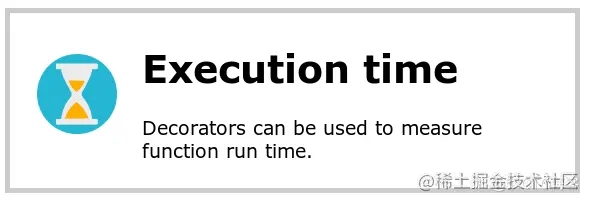Python装饰器
宇宙之一粟 人气:0前言
本文将带你学习装饰器在 Python 中的工作原理,如果在函数和类中使用装饰器,如何利用装饰器避免代码重复(DRY 原则,Don’t Repeat Yourself )。
Python 中的装饰器是什么
装饰器在 Python中是一个非常强大和有用的工具,因为它允许程序员修改函数或类的行为。装饰器允许我们包装另一个函数,以扩展包装函数的行为,而无需修改基础函数定义。这也被称为元编程,因为程序本身在程序运行时会尝试修改自身的另一部分。
装饰器是语法糖: 在代码中利用更简洁流畅的语法实现更为复杂的功能。
我们知道,Python 一切皆对象。这意味着 Python 中的函数可以用作参数或作为参数传递。一等函数的属性:
- 函数是 Object 类型的实例。
- 可以将函数存储在变量中。
- 可以将该函数作为参数传递给另一个函数。
- 可以从函数中返回函数。
- 可以将它们存储在数据结构中,例如哈希表,列表等。
让我们看一个这样的例子。
def hello():
print('Welcome to Python Decorator!')
another_hello = hello()
another_hello
# Welcome to Python Decorator!定义了一个 hello() 函数,然后将 hello 函数分配给 another_hello 变量,然后调用这个变量,得到的结果是 hello 函数被执行。
既然 Python 中的函数是对象,那么除了可以简单的调用之外,就可以把函数作为对象传递给另一个函数。
def print_welcome():
print('Welcome to Python Decorator!')
def print_hello(func):
def inner():
print('Hello!')
func()
return inner
decorated = print_hello(print_welcome)
decorated()
# Hello!
# Welcome to Python Decorator!语法糖
但是,上面的代码使用了内部函数我们可以通过简单地用装饰器函数 print_hello() 来装饰 print_welcome() 函数。
装饰器可以简化我们的操作。功能完全一样,但它的代码更简洁。即通过 @ 符号简化装饰器的使用,如下所示:
def print_hello(func):
def inner():
print('Hello!')
func()
return inner
@print_hello
def print_welcome():
print('Welcome to Python Decorator!')
print_welcome()
# Hello!
# Welcome to Python Decorator!通过这样做,我们能够消除将一个函数显式传递到另一个函数中的使用。Python 装饰器隐式处理这一点。
使用 Python 装饰器修改函数行为
使用 Python 装饰器对函数进行计时
为了演示它们的实用性,让我们构建一个函数,该函数采用另一个函数并对其执行进行计时。在这里,使用装饰器的好处是它允许我们遵循 DRY 编程原则。
装饰器可用于测量函数执行所需的时间。 如果你定义一个简单的睡眠函数,以计算该函数的运行时。

import time
def timeit(func):
def timed():
start = time.time()
result = func()
end = time.time()
print(f'Program took {(end - start) * 1000}s to run')
return result
return timed
@timeit
def print_welcome():
print('Welcome to Python Decorator!')
print_welcome()
# Welcome to Python Decorator!
# Program took 0.0s to run分析一下上面的代码:
- 定义了一个函数
timeit() 接受另一个函数 - 该函数还有另一个内部函数
timed() - 函数跟踪开始时间,执行修饰函数,跟踪结束时间,计算差值并返回结果
- 最后,外层函数返回内层函数
当我们将此装饰器函数应用于我们的函数 print_welcome() 时,首先会返回欢迎问候语,然后显示执行时间。
使用 Python 装饰器将有用信息记录到终端
与上面的例子类似,我们可以在程序运行时使用装饰器将有用的信息打印到终端。例如,我们可能想知道正在运行哪个函数以及当前时间。也可以使用装饰器传递到日志文件:
from datetime import datetime
def log_info(func):
def inner():
print(f'Starting run at {datetime.now()}')
print(f'Running {func.__name__}')
func()
return inner
@log_info
def print_welcome():
print('Welcome to Python Decorator!')
print_welcome()
# Starting run at 2022-03-27 23:26:38.473310
# Running print_welcome
# Welcome to Python Decorator!在上面的示例中,在运行函数之前,我们的装饰器打印当前日期和时间以及将要运行的函数的名称。如果您正在运行较长的脚本,并且只是想知道程序的位置,这可能很有用。
Web app 中使用的装饰器
让我们以 Web 应用程序的用例为例。当您在 Flask 中构建 Web 应用程序时,您总是会编写 url 路由。 每条路线都是 Web 应用程序中的特定页面。 打开页面 /about 可能会调用 about_page() 方法。

@app.route("/about")
def about_page():
return "Website about nachos"将参数传递给 Python 装饰器
到目前为止,您已经学习了如何创建一些有用的 Python 装饰器。然而,这些装饰器都没有传入参数。在本节中,您将学习如何创建接受参数的 Python 装饰器。
为此,我们将允许在 Python 语法魔术解压缩。使用 func_name(*args,**kwargs),它将解压缩所有参数和所有关键字参数。通过在装饰器中使用它,可以确保装饰器将接受任意数量的参数或关键字参数。这使得它们在重复使用时更加实用。
def print_function_name(func):
def inner(*args, **kwargs):
print(f'Running {func.__name__}...')
return func(*args, **kwargs)
return inner
@print_function_name
def add_nums(a, b):
print(a + b)
add_nums(1, 2)
# Running add_nums...
# 3上述方法的美妙之处在于它同时接受位置和关键字参数。因此,即使我们以以下任何格式执行该函数,该函数也将运行:
-
add_nums(1024, 2020) -
add_nums(1024, b = 2021) -
add_nums(a = 1024, b = 2222)
使用多个 Python 装饰器
关于 Python 装饰器的一个有趣的方式是:可以同时使用多个装饰器。这意味着您可以将多个装饰器应用于单个函数。为了理解这一点,来看一个例子:
def one(func):
def inner(*args, **kwargs):
print('1')
return func(*args, **kwargs)
return inner
def two(func):
def inner(*args, **kwargs):
print('2')
return func(*args, **kwargs)
return inner
@one
@two
def speak(text):
print(text)
speak('Hello')
# 1
# 2
# Hello我们的装饰器函数所做的唯一事情就是打印出数字 1 和数字 2。通过将装饰器 @one 放在 @two 之前,您可以将 two()包装的函数包装为 one()。为了说明这一点,您可以切换顺序以查看如何修改行为:
# Changing decorator order
@two
@one
def speak(text):
print(text)
speak('Hello')
# 2
# 1
# Hello通过首先放置 @two 装饰器,该函数成为最外层的函数。
总结
在本文中,我们先了解了什么是 Python 装饰器,它代表元编程的语法糖。 Python 装饰器允许我们修改函数行为并允许我们以不同的方式扩展函数。
接着了解装饰器是什么以及如何使用它们。学习了如何允许将参数传递给 Python 装饰器,学习了几个常见的装饰器有用的工具。最后,如何使用多个装饰器以及装饰器的先后顺序。
参考文章:
加载全部内容